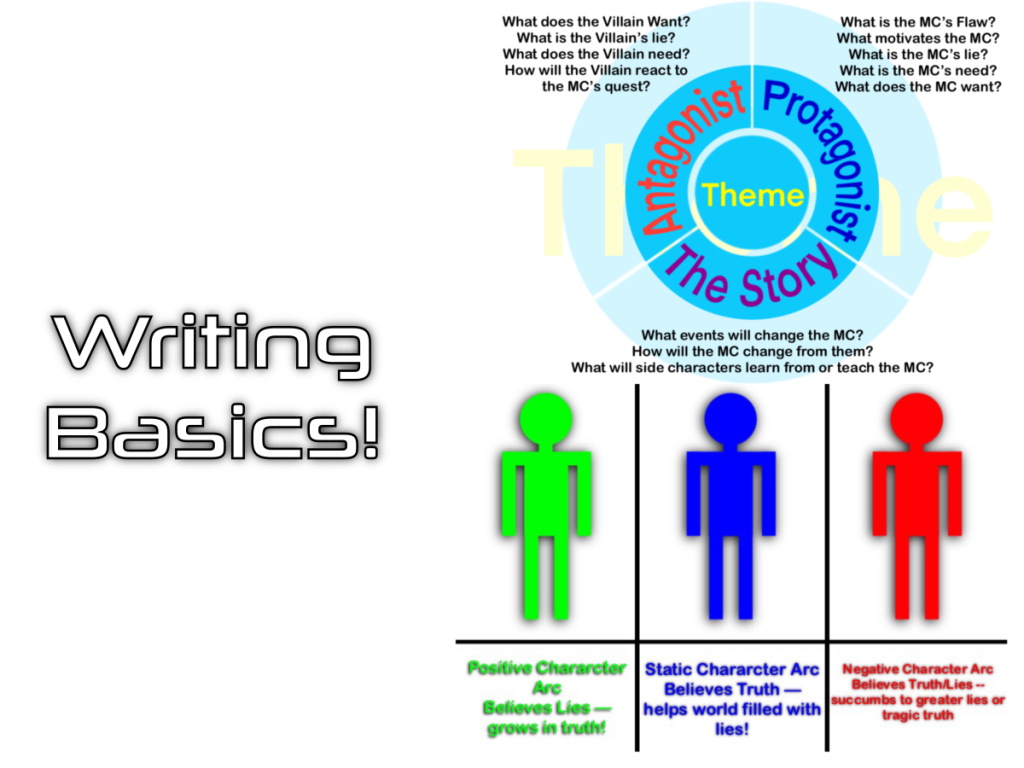All good writing needs three things – Good themes, good character arcs, and good story arcs.
And for each story, the theme is key – leading to the character arcs and story arcs.
Themes are the message of your story.
Every great story needs them. But the key to this is to ensure we show the story, not tell the story, especially for an adult audience.

To say, consent, consent, and consent while interrupting a great scene where two characters connect on a deep emotional level is telling instead of showing.
To have an AI at the end of an amazing Trilogy say, there will always be a conflict between organics and synthetics isn’t showing, it’s telling. Especially when you look at the evidence and see, nope, everything would have been good.
To have a rogue digital person live in another person’s body, and not have an epic battle of wills over who gets to live and who passes on is telling, and not showing.
But you can have great stories, where an old cowboy realizes he needs to be independent to his gang to be his best.
Or you can have a Spider-Man who allows his Aunt May to die, to save the majority of New York, because with great power comes great responsibility.
Or you can have a character whose steadfast faith shows a man who has given up on salvation, a brand new world of faith and love!
That’s the key, don’t tell us your message, show your message – the more you show, the better your story becomes.
Now let’s talk about character arcs. The best way to show the theme of your story is through positive, static and negative character arcs.

Through positive character arcs, we show the message of the story as the character starts shedding the lies they believe to understand the truth.
Arthur Morgan did this in Red Dead Redemption 2. He realizes how following Dutch and the Gang stole his life away, as he faced his mortality because he has TB. Don’t be blindly loyal to people who are no good for you!
Through static character arcs, you have a character who inspires people to fight against the wounds and the lies that hold the world back.
Like Aloy, who uses her compassion, self-reliance, and intelligence to inspire people to learn about the strange mechanical world around them. She acts as the healing agent in a world in desperate need for guidance.
Through negative character arcs, we show the message of the story as the character keeps falling down the rabbit whole, to their and everyone’s destruction.
Like Arthur Fleck, who refused to accept the truth that he was schizophrenic and a murderer – until he did. And then he plunges Gotham into chaos. All because society and a lack of mental health supports prevented him from finding balance.
Finally, with story arcs, we can get right into the meat of the story. And the story arc is always about the antagonist of the story.
Luke wanted to fight the Empire even before finding the droids.
Who is Batman without the Joker?
And Hades was the reason Aloy was born in the first place.
Antagonists have goals, and you have to remind yourself of that. As you write a story/campaign/show/movie/game – while the protagonists make their way through the story, disrupting the plans of the antagonists, the antagonists will not hold back.
They will do whatever they can to prevent the protagonist once they become aware of them.
That leads to the standard storytelling beats.
At first we introduce the protagonist in their normal world.
Then they deny the call to adventure.
Then they are forced out of their normal world and they need to go through the adventure world, because of the antagonistic force.
Then they gain a victory against the antagonistic force.
Then the antagonistic force tries to take them out somehow.
Then the protagonist learns an important truth about the antagonistic force.
Then the character takes on the antagonistic force themselves.
They achieve a partial victory.
But the antagonistic force strikes back – they bring the protagonist to their breaking point/dark moment of their soul.
Then the protagonist fully accepts the truth of what they need to do.
Then the protagonist achieves victory.
Then we give a glimpse in the future of the story.
But there is a tug of war between the protagonist and the antagonistic force through almost all the story.
Storytelling is an art.
You can take all of this, but you need to keep practicing to hone your skills.
The more you do, the better you get.
Remember, show, don’t tell. The best way to do that is have a character learning through all the story. They will achieve great things, as they go through the mysteries that the story presents to them.
If you’re interested in free content for Tales from Trinity City, world building and writing resources, and some thoughts on living your life to the fullest, feel free to join my newsletter.

2 thoughts on “Writing Basics – Themes, Character Arcs, and Story Arcs”